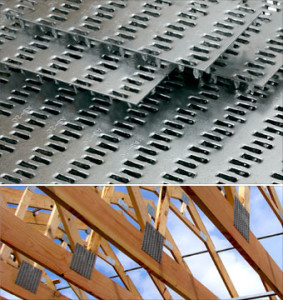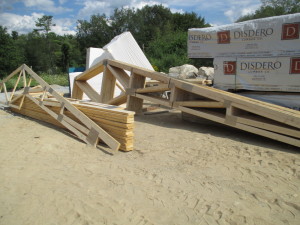A brief gap in the updates on the construction front while I had some business travel to California and Paul awaited delivery of some of the roof trusses. Paul however made progress with getting NStar/Eversource rolling for running electrical power to the house – that should be happening “soon”. The contact and initial jousting over schedules has happened – so hopefully not too long for that.
The trusses arrived and they are very interesting. Part of the plan for this house was to not do a Deck roof throughout the entire space of the house and garage. A Deck roof is a very specialized structure – adapted as the name implies – from house decks, and performed by only some special roofers newcastle. Without going deeply into the details, most of which I am not expert in, what you see from the inside is a cathedral ceiling with massive beams and tongue and groove cedar planking. This allows for really open spaces and lots of wood to be shown. For a different feel (and lower cost) Deck also has a truss based roof system. I chose to utilize that for the mechanical and private areas of the house – I am hoping that this will give the public and private parts of the house two very different feelings or vibe. (note – there is also a different truss system for the floor shown in some of the earlier photos here – allowing for very easy wiring.)
The construction of the trusses themselves is interesting. They are nailed together with standard carpentry nails through galvanized metal plates – gang nail systems. I had not seen these before and I did a little digging – they seem VERY strong and apparently houses in south Florida that were constructed with them survived hurricane Andrew much better than those which were not.

The plates are pierced and form lots and lots of “nails” – so you get a flat surface that has connection to the wood below – across its whole face. Then you use a half dozen carpentry nails for that deep connection. It seems like both a very strong and fast way to build a truss

In some of the earlier photos, you may have noticed the big orange machine in the background – that is Paul Heberts’ Lull Telescopic Lift machine – a key piece of equipment on a Deck House building project from the looks of it. It handles the majority of the heavy work related to taking the flat pack materials from the factory and placing them around the site and for final assembly. My dad happened to capture a series of shots placing a truss.
The trusses are now all in place I believe – or really, really close to being done – so some interior shots below – you can really start to see how it is coming together now. Fantastic progress since June when it was just a hole in the ground waiting for a foundation.
Some design thoughts :
From what I can tell, the house tends to get a fair amount of breeze from the south due to the lay of the land. The south facing glass has more sections that open – so the house is asymmetric in terms of volume and location of openings – my thinking during the design phase is that this might induce a venturi effect when the wind is not blowing strongly – in other words, it will act like a wind sock in low wind speed conditions – the large opening moving to a small. This should generate a compression acceleration of the air speed, creating a proverbial “ahhh – a nice breeze” on day that would normally be considered low wind or even stuffy.
I am starting to think about a post that ties together the design thought process I went through and how it is turning out in reality – maybe even a series of posts with a separate category from “construction”…. hmmm…. 🙂














